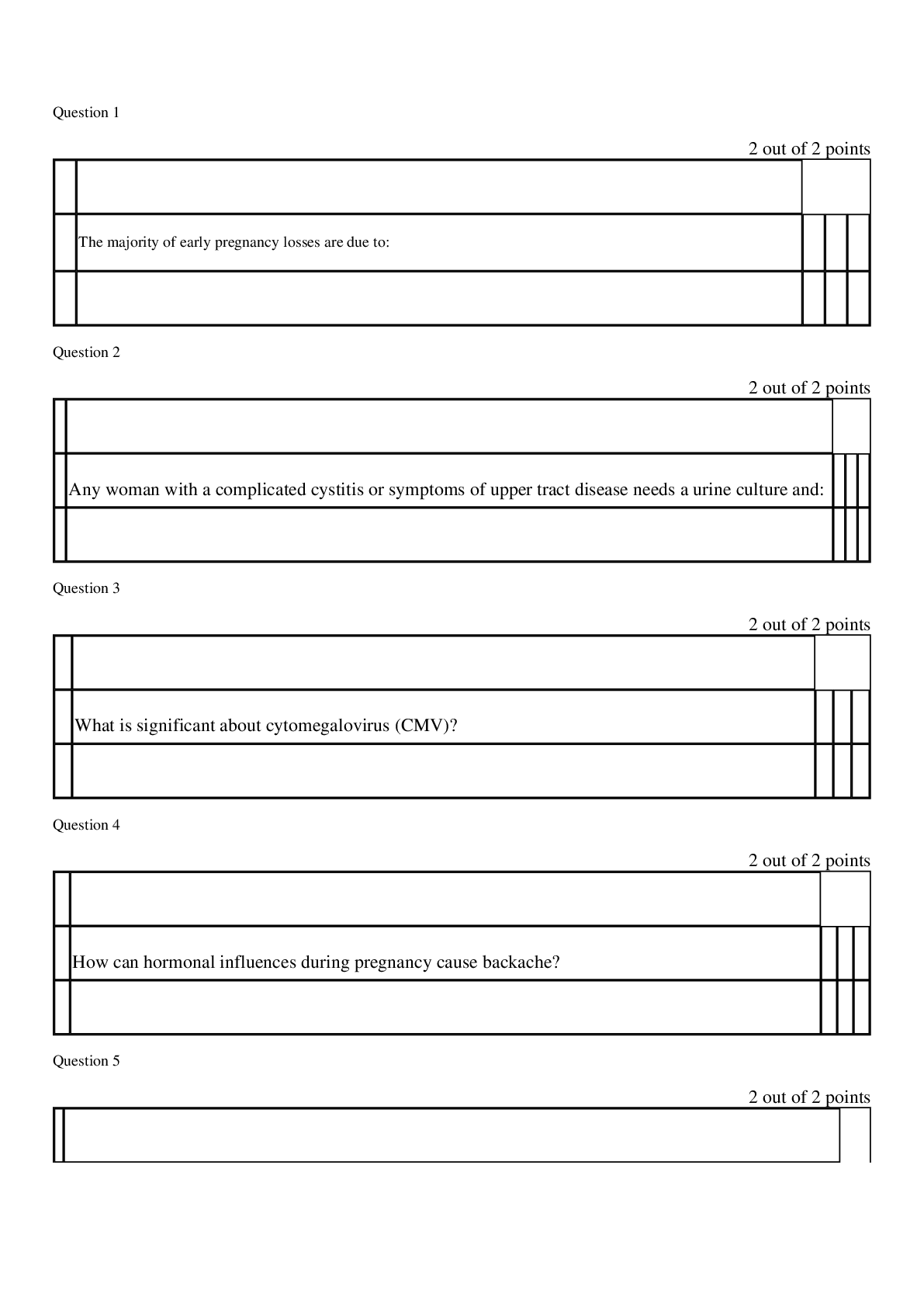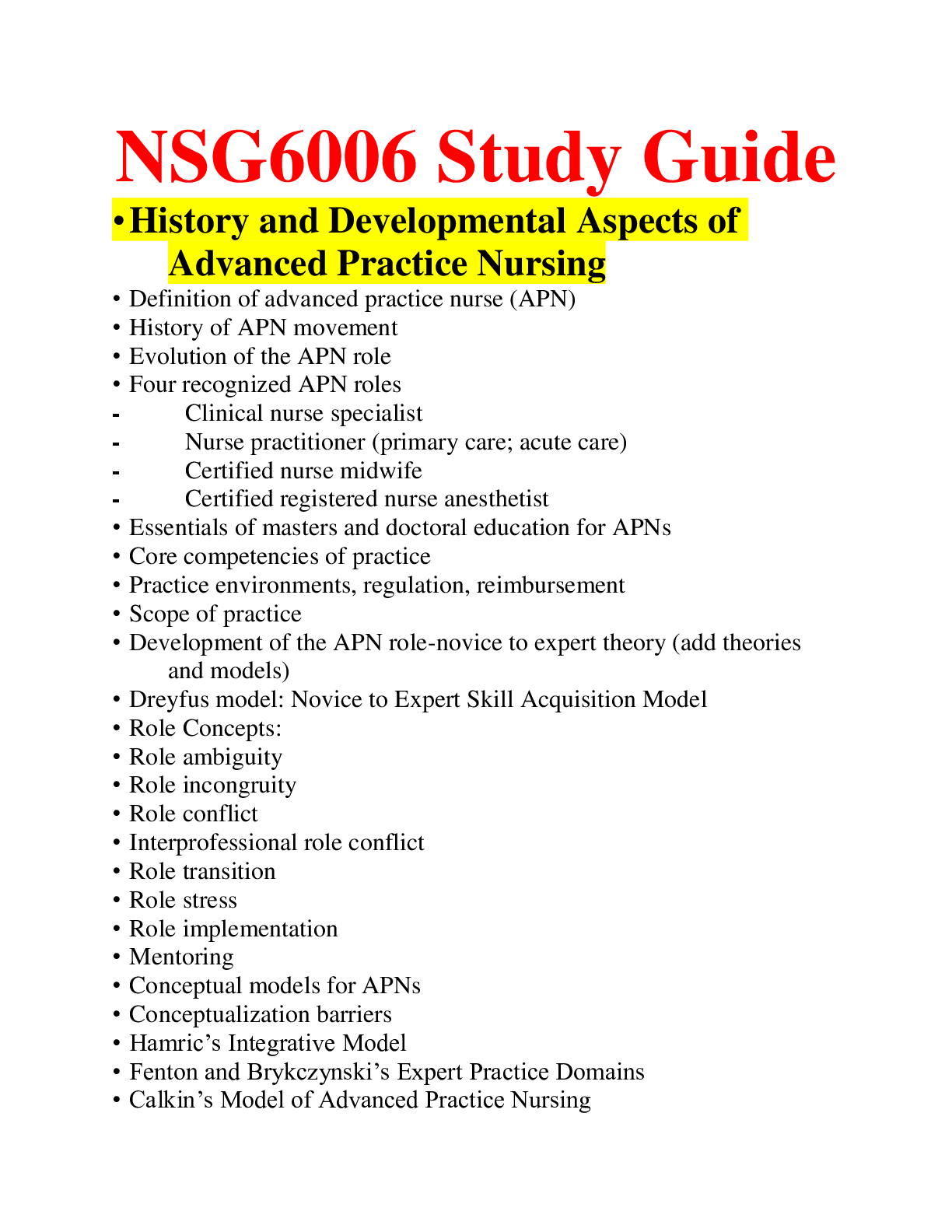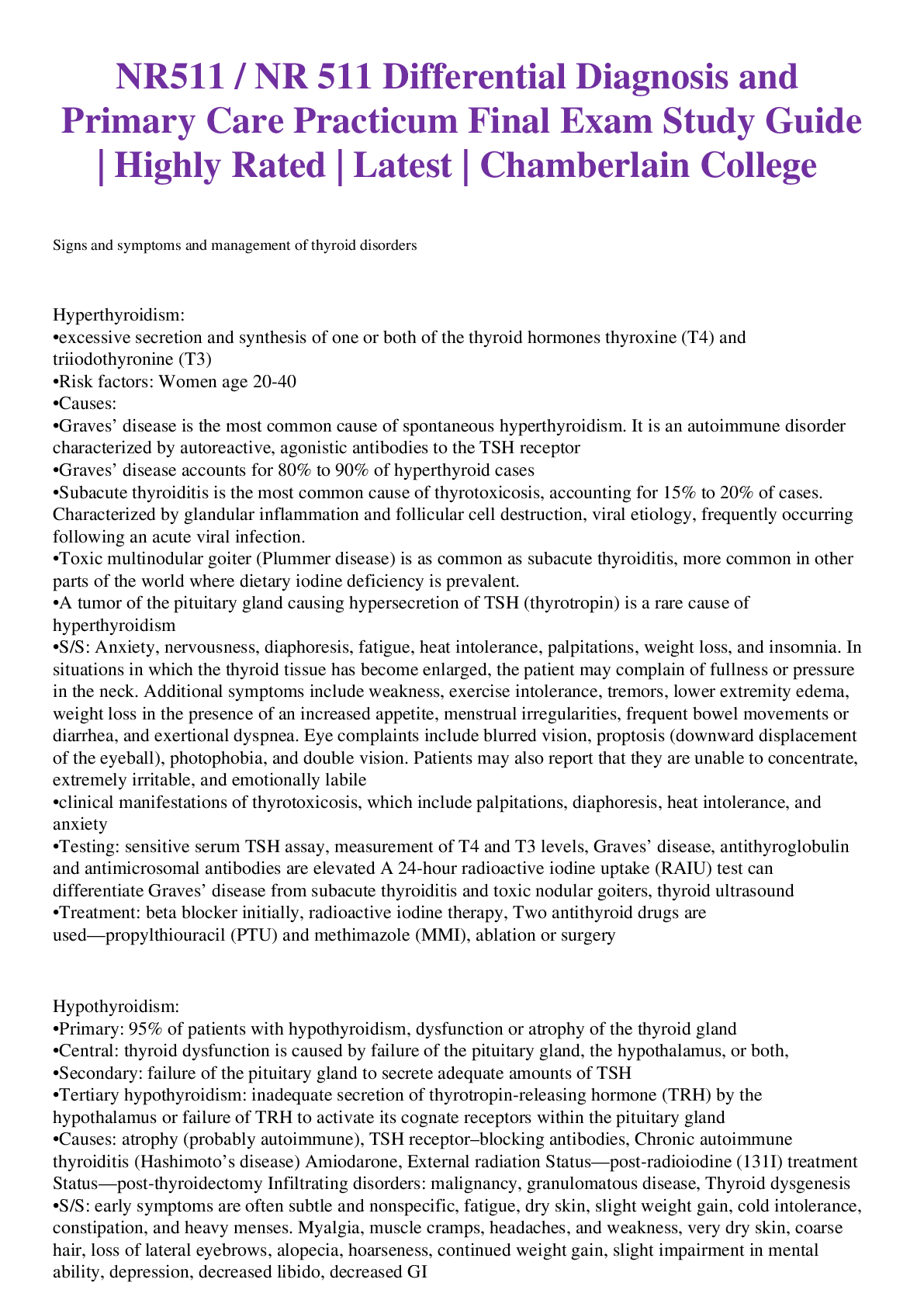*NURSING > STUDY GUIDE > NR 507 Advanced Pathophysiology> Final Exam Study guide| Download to Get A high score(100%) (All)
NR 507 Advanced Pathophysiology> Final Exam Study guide| Download to Get A high score(100%)
Document Content and Description Below
REPRODUCTIVE: endometrial cycle and the occurrence of ovulation uterine prolapse polycystic ovarian syndrome (PCOS) testicular cancer and conditions that increase risk symptoms that require evalu... ation for breast cancer signs of premenstrual dysphoric disorder dysfunctional uterine bleeding pathophysiology of prostate cancer HPV and the development of cervical cancer ENDOCRINE body’s process for adapting to high hormone levels Cushing’s Syndrome causes of hypoparathyroidism lab results that point to primary hypothyroidism pathophysiology of thyroid storm signs of thyrotoxicosis NEUROLOGICAL dermatomes substance release at the synapse Spondylolysis location of the motor and sensory areas of the brain pathophysiology of cerebral infarction and excitotoxins agnosia accumulation of blood in a subarachnoid hemorrhage most common cause of meningitis GENITOURINARY diet and the prevention of prostate cancer Impact of Benign Prostatic Hypertrophy (BPH) on the urinary system GENETICS the role of DNA in genetics transcription effects of genetic mutations Trisomy Down Syndrome Klinefelter syndrome Duchenne muscular dystrophy Neurofibromatosis diseases that have multifactorial traits multifactorial inheritance MUSCULOSKELETAL ions that initiate muscle contraction growth of long bones in children bones belonging to the appendicular skeleton IMMUNITY & INFLAMMATION how vaccines are formed populations at risk for getting systemic fungal infections and parasitic infections systemic manifestations of infection mechanisms responsible for the increase in antimicrobial resistance worldwide functions of normal flora in the body desensitization therapy cells involved in “left shift” in the WBC count differential forms of immunity major histocompatibility class I antigens inflammatory chemicals blocked by anti-inflammatory drugs characteristics of acute phase reactant C-reactive protein DERMATOLOGY process by which a deep pressure ulcer heals complications of the development of contractures during wound healing ACID/BASE causes of respiratory alkalosis molecules that act as buffers in the blood CARDIOVASCULAR most common cardiac valve disease in women when myocardial ischemia may be reversible symptoms of stable angina orthostatic hypotension isolated systolic hypertension results of sustained controlled hypertension the relationship of insulin resistance on the development of primary hypertension defects in the normal secretion of natriuretic hormones and the impact on renal system effects of increased sympathetic nervous system activity due to primary hypertension complications of unstable plaque in the coronary arteries forms of dyslipidemia associated with the development of the fatty streak in atherosclerosis events that initiate the process of atherosclerosis signs and symptoms of increased left atrial and pulmonary venous pressures in left sided heart differences between left and right sided heart failure infective endocarditis PERIPHERAL VASCULAR DISEASE pathophysiology of deep vein thrombosis Vichow’s triad HEMATOLOGY physiological response to hypoxia in anemia populations at the highest risk for developing folate deficiency anemia causes of iron deficiency anemia expected lab test results found in long standing iron deficiency anemia Sickle Cell Anemia causes of aplastic anemia underlying pathophysiologic mechanisms leading to autoimmune hemolytic anemia secondary polycythemia anemia of chronic renal failure FLUIDS & ELECTROLYTES conditions that result in pure water deficit (hypertonic volume depletion) osmoreceptors that stimulate thirst and the release of ADH causes of hypernatremia effects of increased aldosterone dependent edema definition of isotonic principle of capillary oncotic pressure types of fluid compartments in the body PULMONARY most effective measure to prevent pulmonary embolus from developing in patients when the practitioner will note tactile fremitus cause of acute airway obstruction in the patient with chronic bronchitis types of pneumothorax results of the loss of alph-1-antitrypsin in emphysema the result of loss of surfactant in ARDS Characteristics of Cheyne-Stokes respirations SHOCK causes of hypovolemic shock; how the body maintains glucose levels during shock Reproductive: The Menstrual (Ovarian) Cycle: Purpose: Pregnancy and menstrual bleeding (the menses). Starts with Menarche (first menstruation) ends with menopause (cessation of menstrual flow for 1 year). Cycles are anovulatory at first and may vary in length from 10 to 60 days then regular patterns of menstruation and ovulation occur lasting from 21 to 45 days. CYCLE: Commonly accepted cycle average is 28 (27 to 30) days, with rhythmic intervals of 21 to 35 days (Normal). Phases of the Menstrual Cycle: (two phases) 1- the follicular/proliferative phase (postmenstrual) followed by 2- the luteal/secretory phase (premenstrual). Menstruation (menses),the functional layer of the endometrium disintegrates and is discharged through the vagina. Follicular/proliferative phase: GnRH and a balance between activin and inhibin from the granulosa cells contribute to the rise of FSH levels, which stimulates several follicles. The pulsatile secretion of FSH from the anterior pituitary gland rescues a dominant ovarian follicle from apoptosis by days 5 to 7 of the cycle. Together estrogen and FSH increase FSH receptors in the granulosa cells of the primary follicleà making them more sensitive to FSH. FSH and estrogen combine to induce production of LH receptors on the granulosa cells, promoting LH stimulation to combine with FSH stimulation causing a more rapid secretion of follicular estrogen. As estrogen levels increase, FSH levels drop because of an increase in inhibin-B secreted by the granulosa cells in the dominant follicle. This drop in FSH level decreases the growth of less-developed follicles. Estrogen causes cells of the endometrium to proliferate and stimulates production of LH. A surge in both FSH and LH levels is required for final follicular growth and ovulation. An increase in stromal tissue in the late follicular phase is associated with a rise in androgen levels. Androgen production enhances the process of follicle atresia. Luteal/secretory phase (premenstrual): Ovulation is the release of an ovum from a mature follicle and marks the beginning of the luteal/secretory phase of the menstrual cycle. Ovarian follicle begins its transformation a corpus luteum (hence luteal phase) (see Fig. 24.8, A) Pulsatile secretion of LH from the anterior pituitary stimulates the corpus luteum to secrete progesterone, which in turn initiates the secretory phase of endometrial development. Glands from the endometrium start to secrete a thin glycogen-containing fluid (the secretory phase). If conception occurs, the nutrient-laden endometrium is ready for implantation. Human chorionic gonadotropin (HCG) is secreted 3 days after fertilization by the blastocytes and maintains the corpus luteum once implantation occurs at about day 6 or 7. HCG can be detected in maternal blood and urine 8 to 10 days after ovulation. If conception and implantation do not occur, the corpus luteum degenerates and STOPS production of progesterone and estrogen. Without progesterone or estrogen to maintain it, the endometrium becomes ischemic (“blood-starved”) and disintegrates, hence the name ischemic/menstrual phase. Menstruation then occurs, marking the beginning of another cycle. Ovulation Occurs: Ovulatory cycles- minimum length of 24 to 26.5 days: Primary ovarian follicle requires 10 to 12.5 days to develop, and the luteal phase appears relatively fixed at 14 days (±3 days). Menstrual blood flow usually lasts 3 to 7 days, but it may last as long as 8 days or stop after 1 to 2 days and still be considered within normal limits. Bleeding is consistently scant to heavy and varies from 30 to 80 mL, with most blood loss occurring during the first 3 days of menses. Menstrual discharge consists of blood, mucus, and desquamated endometrial tissue and does not clot under normal circumstances. It is usually dark and produces a characteristic musty odor on oxidation. Environmental factors such as severe emotional stress, illness, malnutrition, obesity, and seasonal variation may affect the length of the menstrual cycle. [Show More]
Last updated: 2 years ago
Preview 1 out of 59 pages

Buy this document to get the full access instantly
Instant Download Access after purchase
Buy NowInstant download
We Accept:

Reviews( 0 )
$17.00
Can't find what you want? Try our AI powered Search
Document information
Connected school, study & course
About the document
Uploaded On
Oct 20, 2020
Number of pages
59
Written in
Additional information
This document has been written for:
Uploaded
Oct 20, 2020
Downloads
0
Views
71

























